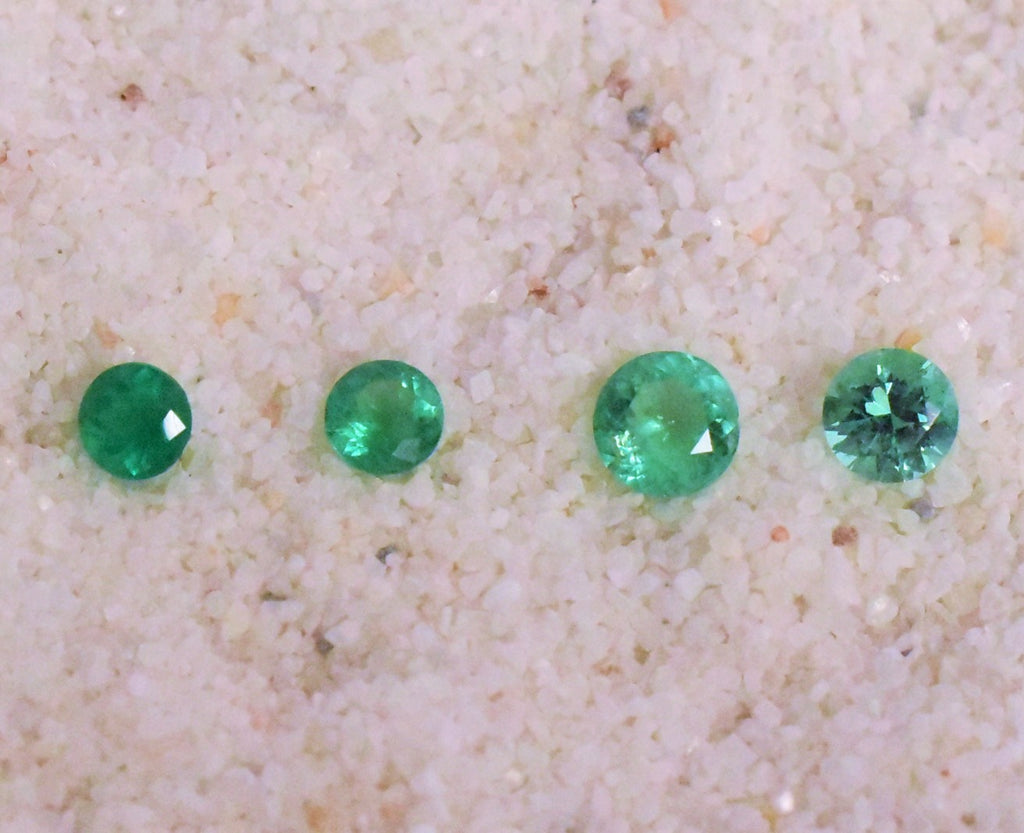What’s up with all these “new” Emeralds: Emerald Origins Revisited

As you may know, emerald is one of my favorite gems. So, it should be somewhat surprising that I have so few in my shop. I can source them, I just can’t photograph them. I just made an engagement ring for someone in the UK and I took some of my best photos for the buyer. Still, his comment to me about the ring when he received it, was “so much more sparkly than in the pictures,” and that the “colors were really vibrant”.
Well, with three “new” emerald origins for me to play with, I am going to have to work on my photography skills. I must show you how gorgeous these greenies are. Note: no emerald origin is “new”, they were always in the ground, but the three origins I am talking about, Panjshir, Russian and Ethiopian, have only recently appeared (and reappeared) on the market.

From left to right: Colombian,Afghanistan, Afghanistan & Russian Emerald

In photo: Panjshir Emeralds

In photo: Colombian Emerald (Listing HERE)
Panjshir Emeralds: these lighter minty green emeralds are mined in the Panjshir Valley in Afghanistan, and improved political relations have made these available in slightly larger quantities. My personal favorite, these gems are extremely vibrant and often cleaner than their counterparts. This website here has some fascinating videos of the mining process in Panjshir. We have some completely untreated material available in very limited quantity, and we can source more material if oil is ok.
Russian Emeralds: these pretties are also lighter, or less saturated, in color, with a touch bluer than the Panjshir and certainly more blue than Colombian emeralds. They are mined in the Ural Mountains, Siberia, and I had never seen any on the market until this year in Tucson although mining there started in the 1830s. I can get limited quantity of un-oiled materials. Here’s a very informative article about history and properties of Russian emerald: http://www.lotusgemology.com/index.php/library/articles/298-emeralds-from-russia-a-closer-look
In photo: Russian Emerald (Listing HERE)
Ethiopian: this find really is new. The Seba Boru district, the area where these emeralds were found, is located about 300 miles south of the capital, Addis Abeba, fairly close to Kenya’s northern border. It started producing mostly commercial grade material in 2016. In contrast to Colombian emeralds, don’t fluoresce, so the color looks very consistent in daylight and in fluorescent lighting. Here’s an article from GIA about Ethiopian emeralds: https://www.gia.edu/gems-gemology/spring-2017-gemnews-new-discovery-emeralds-ethiopia. GIA describes these emeralds as similar in appearance to Brazilian and Zambian material, so not quite as grassy green as the Colombian Muzo emeralds.
And what about the traditional sources of emerald? I would say that what most people regard as the typical emerald color amounts to medium quality Brazilian material: it’s a dark forest green (in part created by blackish inclusions, whereas the inclusions of Colombian material are more typically white). I personally don’t like that material as much. I gravitate towards “glowy” gems in general, my favorites are the warm glowy colors of the medium green Colombian material, or the finest quality Panshir, which is almost neon in color.
To find out more about Colombian emeralds, you’ll have to wait a bit until yours truly goes to Colombia this summer. Right now, the trip is planned for late July, and I hope to visit both the famous Muzo and Chivor mining towns.

